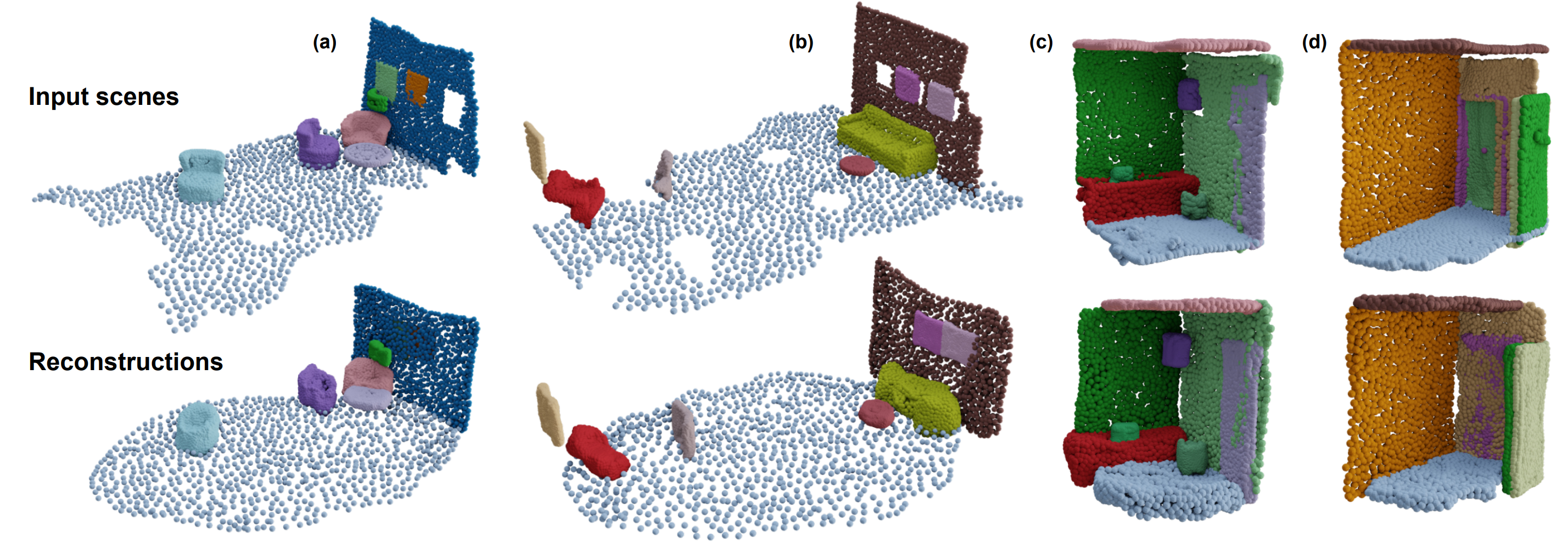
SGRec3D: Self-Supervised 3D Scene Graph Learning
via Object-Level Scene Reconstruction
In the field of 3D scene understanding, 3D scene graphs have emerged as a new scene representation that combines geometric and semantic information about objects and their relationships. However, learning semantic 3D scene graphs in a fully supervised manner is inherently difficult as it requires not only object-level annotations but also relationship labels. While pre-training approaches have helped to boost the performance of many methods in various fields, pre-training for 3D scene graph prediction has received little attention. Furthermore, we find in this paper that classical contrastive point cloud-based pre-training approaches are ineffective for 3D scene graph learning.
To this end, we present SGRec3D, a novel self-supervised pre-training method for 3D scene graph prediction. We propose to reconstruct the 3D input scene from a graph bottleneck as a pretext task. Pre-training SGRec3D does not require object relationship labels, making it possible to exploit large-scale 3D scene understanding datasets, which were off-limits for 3D scene graph learning before. Our experiments demonstrate that in contrast to recent point cloud-based pre-training approaches, our proposed pre-training improves the 3D scene graph prediction considerably, which results in SOTA performance, outperforming other 3D scene graph models by +10% on object prediction and +4% on relationship prediction. Additionally, we show that only using a small subset of 10% labeled data during fine-tuning is sufficient to outperform the same model without pre-training.
 SGRec3D utilizes an encoder-decoder structure for pre-training (bottom-left) using a
reconstruction loss by reconstructing the bounding boxes and shape encodings of objects with supervision from a pre-trained AtlasNet.
The encoder (top-left) generates object and edge embeddings from the input point cloud into a latent graph. The decoder (top-right)
reconstructs the input point cloud from the graph bottleneck. During fine-tuning (bottom-right), the decoder is discarded and the encoder
is fine-tuned to predict the node and edge classes.
SGRec3D utilizes an encoder-decoder structure for pre-training (bottom-left) using a
reconstruction loss by reconstructing the bounding boxes and shape encodings of objects with supervision from a pre-trained AtlasNet.
The encoder (top-left) generates object and edge embeddings from the input point cloud into a latent graph. The decoder (top-right)
reconstructs the input point cloud from the graph bottleneck. During fine-tuning (bottom-right), the decoder is discarded and the encoder
is fine-tuned to predict the node and edge classes.
 We visualize the top-1 object class prediction for each node and the
predicates with a probability greater than 0.5 for each edge. Ground truth labels are shown in square brackets.
We visualize the top-1 object class prediction for each node and the
predicates with a probability greater than 0.5 for each edge. Ground truth labels are shown in square brackets.
 Qualitative results of the reconstructions for four different input scenes. While the reconstruction
does not represent the input scenes perfectly, it is faithful to the input scenes, as object locations are well-preserved. Furthermore, the
shapes look similar and the reconstruction quality is stable.
Qualitative results of the reconstructions for four different input scenes. While the reconstruction
does not represent the input scenes perfectly, it is faithful to the input scenes, as object locations are well-preserved. Furthermore, the
shapes look similar and the reconstruction quality is stable.
@InProceedings{Koch_2024_WACV,
author = {Koch, Sebastian and Hermosilla, Pedro and Vaskevicius, Narunas and Colosi, Mirco and Ropinski, Timo},
title = {SGRec3D: Self-Supervised 3D Scene Graph Learning via Object-Level Scene Reconstruction},
booktitle = {Proceedings of the IEEE/CVF Winter Conference on Applications of Computer Vision (WACV)},
month = {January},
year = {2024},
pages = {3404-3414}
}